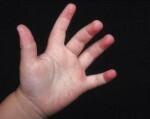Hip dysplasia in children

Newborn babies may show dysplasia of the hip joint in the first month after birth. Dysplasia can be of various types, occurs for various reasons. The most important thing is to diagnose dysplasia of the hip joints in time and start treating the disease in time.
Types of dysplasia of these joints in children
There are several types of disorders in the development of hip joints - from pathological or physiological immaturity of the joint to a dislocation or subluxation.
Physiological, pathological immaturity of the joint is a conditional, less serious degree of dysplasia. If it is not diagnosed, then the ossification is delayed - this is when the articular cartilage does not turn into a bone at one time.
The most dangerous types of dysplasia include preluxation or subluxation of the joint - this is a development of the joint without a bias or with a partial displacement of the head of the femur in relation to the acetabulum.
The most difficult type of hip dysplasia in infants is the dislocation of the femoral head. If this ailment is not detected on time, then it turns out to be such obvious violations, as a limb shortening and a violation of walking function.
A false joint can also develop - not in the place where it should be anatomically, but where the head of the femur has dislocated. The kid is threatened with the grossest violation of motor development, gait disturbance, pain in the joint. Shortening of the leg can reach 10 centimeters.
Causes of development of hip dysplasia in children
Hip dysplasia is a congenital pathology. The reasons for its development may be: a lack of vitamins and trace elements, which are necessary for the proper formation of connective tissue, as well as the mineralization of the cartilaginous tissue;Unbalanced nutrition of a woman during pregnancy;Late pregnancy;toxicosis;Hereditary predisposition. Endocrine and infectious diseases of the mother during pregnancy;Fast or, conversely, prolonged labor;Threat of abortion;Pelvic presentation of the fetus( the most common cause).
Basically, dysplasia in children is diagnosed in the first month of life. In this case, treatment in most cases quickly gives a positive effect.
However, it happens that dysplasia in children does not manifest itself at first, it happens later, under any specific circumstances. Often dysplasia manifests itself in three to six months. Its manifestation can provoke improper care of the child - tight swaddling, lack of gymnastics for children, etc.
Sometimes, dysplasia of the hip joints is detected only by the year when the baby takes the first steps and noticeable abnormalities of the gait. In this case, most likely, not to do without surgery.
What are the signs of dysplasia of this joint in children
Signs of the disease are: limited hip withdrawal from the baby;Different length of legs;A symptom of a "click" is when the joint is clicked with a certain movement of the leg;Asymmetry of the gluteal or inguinal folds. A sign of unidentified dysplasia of the joint may be "raking" the leg with walking.
How to recognize this disease of hip joints
The child is examined by specialists in the first days. Then the parents should regularly bring the baby to the planned examination at the polyclinic.
The child should be shown to the orthopedist in a month, at three, six months and a year. Infringements are revealed can be on any of such inspections. It is especially difficult to recognize dysplasia if the pathology is bilateral.
If, for example, the knee can be palpated, the hip joint is deep enough - it should not be properly palpated. That's why orthopedic doctors recommend to direct the child to ultrasound of the hip joints( when the baby turns a month).This method is harmless, which allows you to accurately determine whether there is a pathology. Also, parents themselves must examine their baby.
If the parents think that the gluteal or groin folds are asymmetrically located, that one leg of the baby is shorter than the other, that when there are movements, a suspicious click or crunch is heard, it is necessary to consult an orthopedist for advice, the earlier, the better.
With the timely diagnosis and treatment, by the age of 5-7 months all the functions of the hip joint in children are practically restored and even with a significant deviation from the norm.



